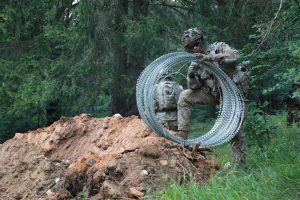Five Forms Every Officer Should Know

Forms play a crucial function in the Army. But knowing what form to use and when to use it can be frustrating. Information about forms is not always covered at commissioning sources or during an officer’s basic course. And learning through trial and error is not efficient – or always pleasant!
This article aims to show you where you can go to get all the forms you might need as a junior officer and to provide insight into the most common forms I have used so far.
As a side note, each form I cite in this article can be found on the Army Publishing Directorate, which I highly recommend you have bookmarked in your workspaces.
Here are five forms I have used the most in the Army.
1. DA Form 2062 (for Property Accountability)
Use the DA Form 2062 (Hand Receipt) to transfer the responsibility of your property to another individual temporarily.
All Army equipment belongs to someone. A responsible officer will sign down equipment to another person (usually the end-user) to ensure accurate property accountability. Use the DA Form 2062 to sign down equipment that you own.
Here are some common situations where you would use this form:
– As a platoon leader signing down equipment to your squad or team leaders
– When borrowing equipment from another individual/unit, or when an outside unit is borrowing equipment from you
– When your equipment needs maintenance, you sign over those pieces to the right people who are conducting maintenance (especially radios, vehicles, and weapons)
Always keeping accountability of your equipment is essential for you as an officer. The DA Form 2062 will help maintain control of your property.
2. DA Form 4856 ( for Developmental Counseling)
Army leaders use the DA Form 4856 (Developmental Counseling Form) to counsel Soldiers.
Since development is a vital component of the Army, there was a need to document progress or regression based on the Soldier’s behavior.
Here are some typical situations where you would use this form:
– Initial counseling and quarterly counseling of NCOs (and eventually Officers) that you rate/senior rate
– Event Counseling for violations of the Unformed Code of Military Justice (UCMJ)
– Event Counseling to correct a Soldier’s habitually poor behavior; i.e., frequently late to formation, violations under AR 670-1 (Wear and appearance of Army Uniforms and Insignia)
– Monthly Professional Growth Counseling for Soldiers
The DA Form 4856 is a powerful tool to help tailor your development and provide leadership to those you rate.
3. DA Form 4187 (for Personnel Actions)
All Army forms are essential, but the DA Form 4187 (Personnel Action) is one of the most frequently used forms in the Army. For example, administrative actions from inter-post transfers to tests at base testing centers will require a 4187.
Here are several common situations where you’ll need a 4187:
– Getting a new identification card
– Taking a test at the testing center
– Inter-post transfers
– Name change
Take a few minutes to review a Personnel Action Form to see other occasions that would require this form.
Your S1 shop Soldiers are experts on 4187s. So ask them if you have more specific questions.
4. DD Form 2977 (for Assessing Risk in Military Operations)
Each training event you plan will require a DD Form 2977 Deliberate Risk Assessment Worksheet, or DRAW. Reducing risk in military operations is the overall goal for completing the DRAW.
The DRAW helps identify risk and emplace mitigating factors to reduce the likelihood of an incident during training. For example, suppose I were to conduct an M4 range. In that case, I think about all the hazards associated with range operations: weather, fratricide, injury, vehicle operations, burns from brass, wildlife, etc. For each one of these hazards, I would develop a control measure and assign someone responsible for implementing that control. Again, all of those details go on the DRAW.
Fortunately, the DRAW is an easy form to use. Remember, every training exercise requires a DRAW, so there are no ‘common’ situations where you wouldn’t use one of these. Risk management is an integral part of the military, and leaders must ensure the safety of their Soldiers.
Finally, make sure you’re using the most recent DD Form 2977. There are several previous versions, with the most common being from 2014. The newest one is from November 2020, which I linked at this section’s beginning. So download the form and start filling it out.
5. DD93 (the Emergency Data Form)
The DD 93 (Record of Emergency Data) is one of the most important forms you’ll complete in the Army. Therefore, it’s important enough that your S1 shops track these and ensure that each Soldier reconfirms their information yearly.
Be as accurate as possible when filling out your DD 93. Redo it if your situation has changed (e.g, did you get married, divorced, have children, etc.). You’ll also likely end up monitoring if your Soldiers’ DD93s are up to date (verified within the last 365 days). Most units track this information as part of unit readiness. You can’t deploy if your DD93 is not up to date.
Conclusion
Use this article as a resource for a few common forms you’ll find in the Army. Although there are many, these are the ones I interacted with the most in my career thus far.
As always, you’ll have support in your S3 shops and company operations section if you don’t know which forms to use for situations you encounter. And refer to the Army Publishing Directorate for all forms relating to the Army or Department of Defense.
I hope you learned something from this article. What forms have helped you thus far in your Army career?
————-
CPT Robert Perez is a Civil Affairs officer and has been in the active duty Army for eight years. He enjoys reading, writing, and spending time with his family. You can reach him at Robert.f.perez17.mil@army.mil.
Related Posts

Fighting as an Enabler Leader
(U.S. Army Photo by Cpl. Tomarius Roberts, courtesy of DVIDS)Enablers provide capabilities to commanders that they either do not have on their own or do not have in sufficient quantity …

Defeating the Drone – From JMRC’s “Skynet Platoon”
If you can be seen, you can be killed—and a $7 drone might be all it takes. JMRC’s Skynet Platoon discuss their TTPs to defeat the drone.

3 Deployments Before Captain: Reflections From Down Range
Deployments challenge junior officers beyond their primary duties, often demanding adaptability, wellness management, proactive leadership, and moral integrity maintenance.
